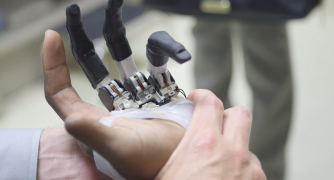 Two OrthoCarolina hand surgeons have successfully completed the first surgery to allow for a prosthetic hand with individual finger control on an amputee patient. Partnering with OrthoCarolina Research Institute (OCRI) in pursuit of medical breakthroughs through orthopedic research, Drs. Glenn Gaston and Bryan Loeffler conceptualized and performed the procedure involving transferring existing muscle from the fingers to the back of the hand and wrist without damaging the nerves and blood vessels to the muscles. The patient who underwent the test surgery is now able to control individual prosthetic fingers using the same muscles that controlled his fingers pre-amputation, making him the first person in the world to have individual digit control in a functioning myoelectric prosthesis.
Two OrthoCarolina hand surgeons have successfully completed the first surgery to allow for a prosthetic hand with individual finger control on an amputee patient. Partnering with OrthoCarolina Research Institute (OCRI) in pursuit of medical breakthroughs through orthopedic research, Drs. Glenn Gaston and Bryan Loeffler conceptualized and performed the procedure involving transferring existing muscle from the fingers to the back of the hand and wrist without damaging the nerves and blood vessels to the muscles. The patient who underwent the test surgery is now able to control individual prosthetic fingers using the same muscles that controlled his fingers pre-amputation, making him the first person in the world to have individual digit control in a functioning myoelectric prosthesis.
“Patients who have sustained full or partial hand amputations obviously have significant morbidity and limited function, which is a challenge. Because of the limited number of muscles available after a hand amputation, prostheses have previously allowed only control of the thumb and fingers as a group and single finger control was never possible,” said Dr. Glenn Gaston. “The severity of this patient’s injury was so great that replanting the lost fingers was not possible, so we collaborated on a new surgery that would allow him to have individual digital control.”
Hypothesizing that existing muscle in the back of human fingers could be transferred to the back of the hand and wrist without damaging the nerves and blood vessels to those muscles, Drs. Gaston and Loeffler first performed cadaveric testing to ensure feasibility. The goal of the initial project was for the small muscles that control individual fingers to regain control of prosthetic fingers by maintaining enough blood and nerve supply to allow the prosthetic limb to recognize individual digits.
With successful research completed, they collaborated with the Hanger Clinic to determine how much bone would be required to be removed from the hand, allowing the prosthetic componentry enough space to maintain a normal hand length.
The two surgeons jointly performed the surgery as a pilot case on a partial hand amputee, moving the muscles while still allowing the prosthesis to detect signals from the transferred muscles; a procedure never before reported in orthopedic literature.
“Imagine the limitations you would have if all of your fingers had to move as one unit, and then suddenly you were able to move individual fingers to perform specific actions,” said Dr. Bryan Loeffler. “This muscle transfer is a breakthrough that could impact how upper extremity amputees are managed and specific amputations are done in the future.”
Drs. Loeffler and Gaston have completed a cadaver model demonstrating the capability of the same type of surgery for a more proximal level total hand amputation. They presented their research at a podium presentation to the First International Symposium on Innovations in Amputation Surgery and Prosthetic Technologies (IASPT) May 12-13, 2016 in Chicago.
OrthoCarolina Research Institute is an independent non-profit committed to the advancement of orthopedic practice through clinical research. OCRI will continue to support this ground-breaking research and the manufacturing of this cutting edge prosthesis. “This is a tremendous example of the life-changing impact that orthopedic research plays in advancing patient outcomes,” said Christi Cadd, Executive Director of OCRI.
Back